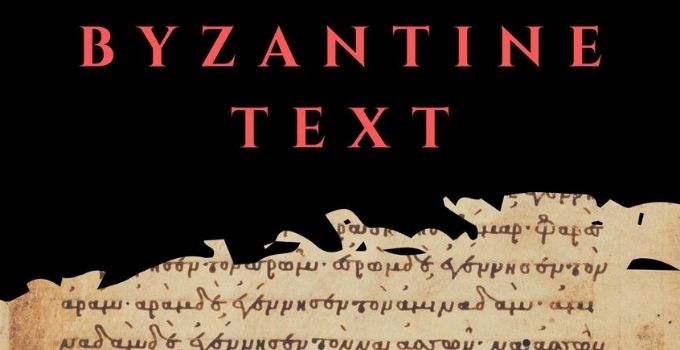The Byzantine Kr/family 35 Text-Form (1261-1453 C.E.)
IT IS ARGUED THAT THE BYZANTINE KR/FAMILY 35 TEXT-FORM IS ...
(1) It is the most carefully controlled and textually unified group of Byzantine MSS that were produced.
(2) It is the Textus Receptus before the Textus Receptus. It is the Majority Text before the Majority Text.
Some Byzantine supporters argue that "It [Byzantine Kr/family 35 Text-Form] is the most carefully controlled and textually unified group of Byzantine MSS that were produced." Moises Rodrigues Coimbra, a Facebook New Testament Textual Studies group, has said it this way, "it is very common to hear (at least for those who defend this MSS family) That the Byzantine Kr/family 35 text-form is the most precise and uniform grouping of New Testament manuscripts ever produced." Astonishingly, that sounds quite impressive; when, in fact, really, it is not! You see, some have mistakenly taken these types of comments and the careful scribal work to produce a standard text of sorts from the Byzantine family of manuscripts to produce the Byzantine Kr/family 35 text-form with also being the most accurate text. The Byzantine Kr/family 35 Text-Form of the 13th-15th centuries is the Textus Receptus before there was the Textus Receptus. The Textus Receptus is a corrupt critical text by Desiderius Erasmus in the 16th-century made from about half a dozen 12th-century Byzantine manuscripts. It is a Majority Text before there was the Majority. The Majority Text was produced in the 20th-century by Zane C. Hodges and Arthur L. Farstad as well as Robinson & Pierpont. It is called the Majority Text because it is considered to be the Greek text established on the basis of the reading found in the vast majority of the Greek manuscripts (Byzantine Family). The Textus Receptus differs from the Majority Text in 1,838 Greek readings, of which 1,005 represent "translatable" differences.
Responding to the Byzantine Advocate
The Family 35 group is the result of an early 12th-century attempt to create a unified New Testament text. So, they took Byzantine manuscripts at that time and tried to create a majority text in the 12th-century. So, if the Byzantine text is corrupt from its start in the fifth century C.E. and then copies of those corruptions were repeated and added to over the next 800 years and then they try and create a standard text from corrupt texts, you have a corrupt text. Yes?
In addition, by attempting to create a unified text in the 12-century, they have to openly admit that the Byzantine family was not unified all along. Otherwise, why created a standard text and then work so hard to make perfect copies. Thus, if it is not unified; then, even trying to pick the best readings from the 12-century manuscripts that created Family 35, you are picking from corrupt manuscripts to do so. And making the argument, which they do that “the copying was controlled and the accuracy is unequaled in the history of the transmission of the New Testament text” does not still answer (1) the Byzantine corruption period prior to, (2) nor deal with the Alexandrian Family that dates 200-250 years earlier than the earliest Byzantine text.
It is said of the Kr/family 35 Text-Form that it is the most precise and uniform grouping of New Testament manuscripts ever produced. What does that mean exactly? Really, it means nothing other than the Byzantine text-type dominated throughout the Byzantine Empire from 395-1453 C.E. and for 800 many major copyists errors like Mark 16:9-20, John 7:53-8:11, and 1 John 5:7-8 were repeatedly copied and recopied. However, during manuscript production, through the late Byzantine Empire (1261-1453) the scribes managed to copy precise uniform copies of texts that were already corrupt. Byzantine manuscripts have fewer disagreements is a common claim but that could hardly be the case when they make up 4,000+ of the 5898 Greek NT manuscripts. And even if so, it is a period with many very professional scribes all doing the work. But as was said, the horse (corruptions) was already out of the barn, so closing the door (professional scribes taking great liberties to be precise and uniform), was a bit futile.
FULL ARTICLE
The Byzantine Kr/family 35 Text-Form (1261-1453 C.E.)
https://christianpublishinghou....se.co/2020/07/26/the
THREE BOOKS
THE KING JAMES BIBLE: Do You Know the King James Version?
https://www.amazon.com/dp/194575799X
THE KING JAMES BIBLE: Why Have Modern Bible Translations Removed Many Verses That Are In the King James Version?
https://www.amazon.com/dp/1949586960
HISTORY OF ENGLISH VERSIONS OF THE BIBLE
https://www.amazon.com/dp/1949586979
TIP: As this platform only has 3 visibility settings
(Everyone, Friends, Only Me)
if you want to interact with people without laying bare your whole life,
try creating a page, group, or topic in the forum.
GROUPS can be set to private/invite only.
Don't forget to change the privacy settings on your posts
if you don't want everyone to see them!





